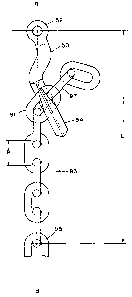Some of the information on this Web page has been provided by external sources. The Government of Canada is not responsible for the accuracy, reliability or currency of the information supplied by external sources. Users wishing to rely upon this information should consult directly with the source of the information. Content provided by external sources is not subject to official languages, privacy and accessibility requirements.
Any discrepancies in the text and image of the Claims and Abstract are due to differing posting times. Text of the Claims and Abstract are posted:
| (12) Patent: | (11) CA 2083989 |
|---|---|
| (54) English Title: | GRAB HOOK FOR ATTACHMENT TO A CHAIN TO PROVIDE PARTIAL LINK ADJUSTMENT |
| (54) French Title: | CROCHET PRENEUR POUR CHAINE ET PERMETTANT DE REGLER PARTIELLEMENT LE MAILLON |
| Status: | Term Expired - Post Grant Beyond Limit |
| (51) International Patent Classification (IPC): |
|
|---|---|
| (72) Inventors : |
|
| (73) Owners : |
|
| (71) Applicants : |
|
| (74) Agent: | LAMBERT INTELLECTUAL PROPERTY LAW |
| (74) Associate agent: | |
| (45) Issued: | 2003-05-06 |
| (22) Filed Date: | 1992-11-27 |
| (41) Open to Public Inspection: | 1994-05-28 |
| Examination requested: | 1999-10-26 |
| Availability of licence: | N/A |
| Dedicated to the Public: | N/A |
| (25) Language of filing: | English |
| Patent Cooperation Treaty (PCT): | No |
|---|
| (30) Application Priority Data: | None |
|---|
A hook for gripping chain is asymmetrical so
that the effective chain length can be adjusted to a part
link tightness. The attachment end of the hook is offset
from the plane of the hook end, which includes the slot
for receiving a link of a chain. If the chain enters from
one side of the hook, the chain and hook nave a different
angle than when the chain enters from the other side of
the hook. The resulting change in angle and hence the way
the hook interferes with the chain changes the length of
chain required for the chain to reach the slot.
Note: Claims are shown in the official language in which they were submitted.
Note: Descriptions are shown in the official language in which they were submitted.

2024-08-01:As part of the Next Generation Patents (NGP) transition, the Canadian Patents Database (CPD) now contains a more detailed Event History, which replicates the Event Log of our new back-office solution.
Please note that "Inactive:" events refers to events no longer in use in our new back-office solution.
For a clearer understanding of the status of the application/patent presented on this page, the site Disclaimer , as well as the definitions for Patent , Event History , Maintenance Fee and Payment History should be consulted.
| Description | Date |
|---|---|
| Revocation of Agent Requirements Determined Compliant | 2020-04-22 |
| Appointment of Agent Requirements Determined Compliant | 2020-04-22 |
| Inactive: Expired (new Act pat) | 2012-11-27 |
| Inactive: Late MF processed | 2011-02-14 |
| Inactive: Adhoc Request Documented | 2011-01-28 |
| Letter Sent | 2010-11-29 |
| Grant by Issuance | 2003-05-06 |
| Inactive: Cover page published | 2003-05-05 |
| Pre-grant | 2003-02-20 |
| Inactive: Final fee received | 2003-02-20 |
| Notice of Allowance is Issued | 2002-12-10 |
| Notice of Allowance is Issued | 2002-12-10 |
| Letter Sent | 2002-12-10 |
| Inactive: Approved for allowance (AFA) | 2002-11-21 |
| Amendment Received - Voluntary Amendment | 2002-10-17 |
| Inactive: S.30(2) Rules - Examiner requisition | 2002-09-23 |
| Amendment Received - Voluntary Amendment | 2000-02-24 |
| Inactive: Application prosecuted on TS as of Log entry date | 1999-11-26 |
| Letter Sent | 1999-11-26 |
| Inactive: Status info is complete as of Log entry date | 1999-11-26 |
| Request for Examination Requirements Determined Compliant | 1999-10-26 |
| All Requirements for Examination Determined Compliant | 1999-10-26 |
| Application Published (Open to Public Inspection) | 1994-05-28 |
| Small Entity Declaration Determined Compliant | 1992-11-27 |
There is no abandonment history.
The last payment was received on 2002-11-15
Note : If the full payment has not been received on or before the date indicated, a further fee may be required which may be one of the following
Please refer to the CIPO Patent Fees web page to see all current fee amounts.
Note: Records showing the ownership history in alphabetical order.
| Current Owners on Record |
|---|
| DOUGLAS JOHN MACKENZIE |
| Past Owners on Record |
|---|
| None |